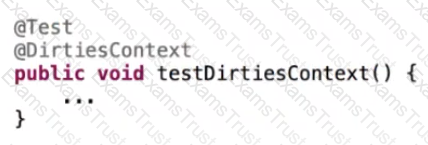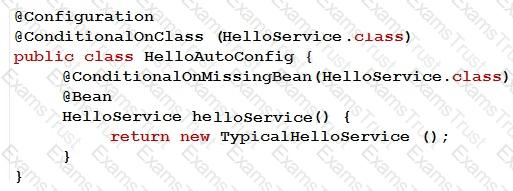Which option is true about use of mocks in a Spring Boot web slice test? (Choose the best answer.)
Refer to the exhibit.

What statement is true about @DirtiesContext?
Spring puts each bean instance in a scope. What is the default scope? (Choose the best answer.)
Which two statements are true regarding Spring Boot Testing? (Choose two.)
Which two statements are true about @Controller annotated classes? (Choose two.)
Which two annotations are meta-annotations on the @SpringBootApplication composed annotation? (Choose two.)
Refer to the exhibit.

Which statement is true? (Choose the best answer.)
Which two statements are true regarding a Spring Boot "fat" JAR? (Choose two.)
Which two statements are correct regarding the Actuator loggers endpoint? (Choose two.)
In which three ways are Security filters used in Spring Security? (Choose three.)
Which two options are application slices that can be tested with Spring Boot Testing? (Choose two.)
Which two statements are true concerning constructor injection? (Choose two.)
What are the two reasons Spring be used to build a Java application? (Choose two.)
Which two statements describe Spring JdbcTemplate? (Choose two.)
Which two statements are correct regarding the differences between @ConfigurationProperties and @Value? (Choose two.)
Which statement defines a pointcut? (Choose the best answer.)
Which two statements are true about REST? (Choose two.)
Which two mechanisms of autowiring a dependency when multiple beans match the dependency's type are correct? (Choose two.)
Which strategy is correct for configuring Spring Security to intercept particular URLs? (Choose the best answer.)
Refer to the exhibit.

Which two statements are correct regarding the HelloAutoConfig auto-configuration class when it is specified in the META-INF/spring.factories file? (Choose two.)
Which two statements about BeanFactoryPostProcessors are true? (Choose two.)
Which two statements are correct regarding the Health Indicator status? (Choose two.)
Refer to the exhibit.

Which option is a valid way to retrieve the account id? (Choose the best answer.)